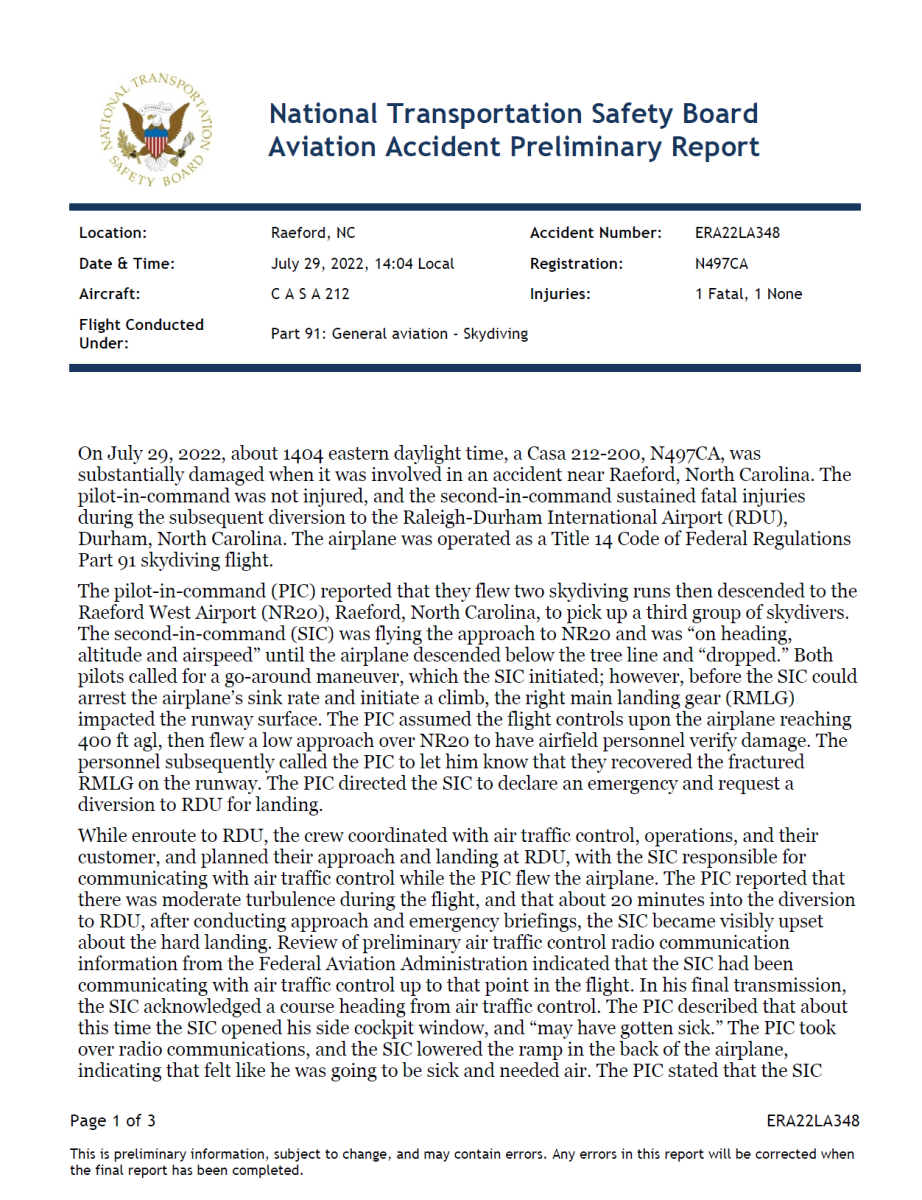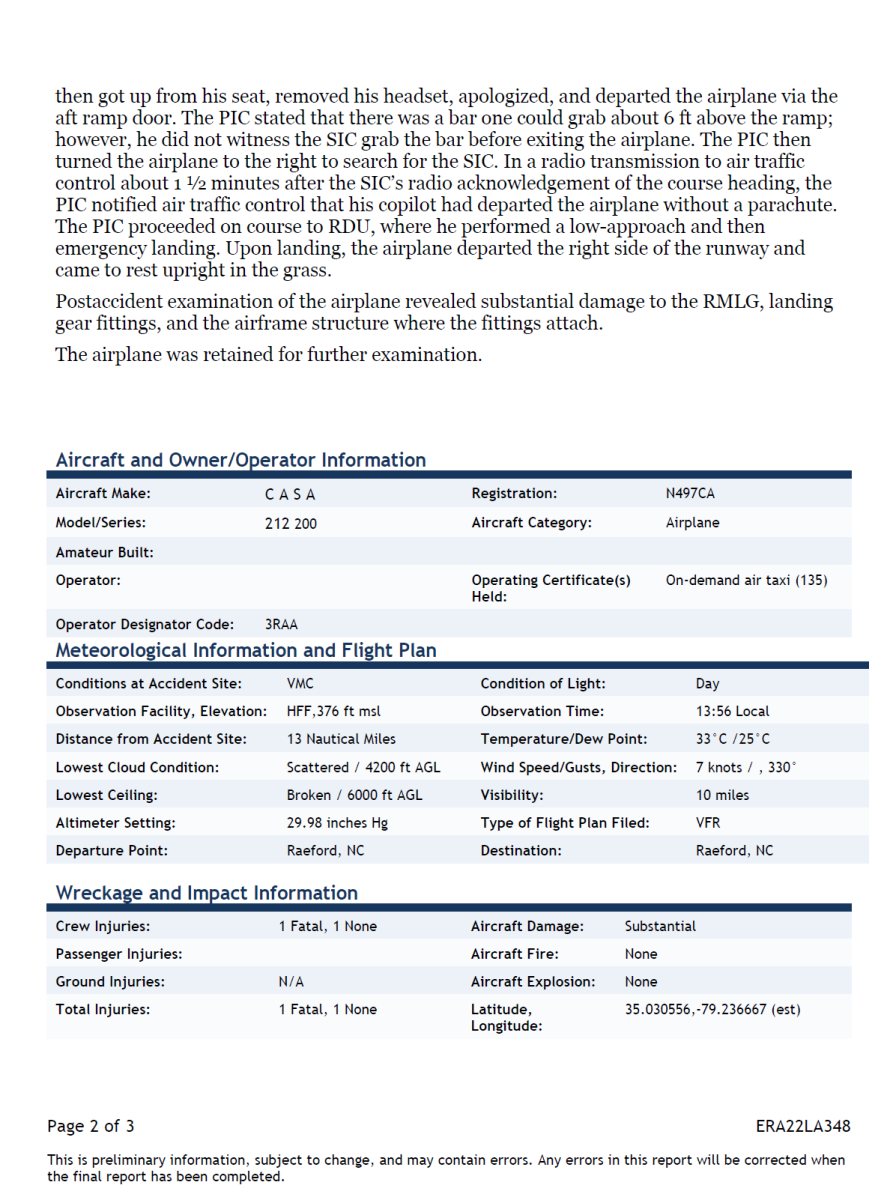


The death of Pilot Charles Hew Crooks drew national attention after his mysterious death on July 29th , after an alleged midair exit from the Plane. NTSB is still investigating the matter to figure out different aspects in it to produce a final report , while Aviation fraternity is disturbed about the unexpected event.
But , a Preliminary report on Tuesday, that is based on the Pilot in command's report , indicates that Crooks was visibly so upset with a mishap (hard landing) earlier in the flight that, he exited the plane.

On July 29, 2022 , a Rampart Aviation Casa 212-200 aircraft , registered N497CA was engaged in skydiving activity. After doing two skydiving runs, the aircraft descended to the Raeford West Airport (NR20), Raeford, North Carolina, to pick up a third group of skydivers.
NTSB report says ,
The second-in-command (SIC) was flying the approach to NR20 and was “on heading, altitude and airspeed” until the airplane descended below the tree line and “dropped.” Both pilots called for a go-around maneuver, which the SIC initiated; however, before the SIC could arrest the airplane’s sink rate and initiate a climb, the right main landing gear (RMLG) impacted the runway surface.
The PIC assumed the flight controls upon the airplane reaching 400 ft agl, then flew a low approach over NR20 to have airfield personnel verify damage. The personnel subsequently called the PIC to let him know that they recovered the fractured RMLG on the runway. The PIC directed the SIC to declare an emergency and request a diversion to RDU for landing.
NTSB report Further adds ,
While enroute to RDU, the crew coordinated with air traffic control, operations, and their customer, and planned their approach and landing at RDU, with the SIC responsible for communicating with air traffic control while the PIC flew the airplane.
The PIC reported that there was moderate turbulence during the flight, and that about 20 minutes into the diversion to RDU, after conducting approach and emergency briefings, the SIC became visibly upset about the hard landing.
The PIC continued to fly the aircraft while Crooks communicated with air traffic controllers as they prepared to land at Raleigh-Durham International Airport (RDU) with the right landing gear missing, the pilot told the NTSB.

The pilot also gave his statement to the NTSB that Crooks then lowered the ramp in the back of the airpcraft , indicating that he felt like he was going to be sick and needed air. The pilot said he took over radio communication as Crooks “got up from his seat, removed his headset, apologized, and departed the airplane via the aft ramp door.”
Review of preliminary air traffic control radio communication information from the Federal Aviation Administration indicated that the SIC had been communicating with air traffic control up to that point in the flight. In his final transmission, the SIC acknowledged a course heading from air traffic control.
The PIC described that about this time the SIC opened his side cockpit window, and “may have gotten sick.” The PIC took over radio communications, and the SIC lowered the ramp in the back of the airplane, indicating that felt like he was going to be sick and needed air.
The PIC stated that the SIC then got up from his seat, removed his headset, apologized, and departed the airplane via the aft ramp door.

Investigator In Charge (IIC): Spencer, Lynn
Additional Participating Persons: Mike Allen; FAA/FSDO; Greensboro, NC .
Audio recordings of 911 calls and radio traffic suggests , the PIC had informed that Crooks had “jumped” out of the plane without a parachute. The surviving pilot also reported potential coordinates of Crooks’ location before landing at RDU.
In a radio transmission to air traffic control about 1 ½ minutes after the SIC’s radio acknowledgement of the course heading, the PIC notified air traffic control that his copilot had departed the airplane without a parachute.
The PIC proceeded on course to RDU, where he performed a low-approach and then emergency landing. Upon landing, the airplane departed the right side of the runway and came to rest upright in the grass.
Crooks was passionate about aviation and flying , after becoming a professional pilot , he had qualified as a commercial pilot and certified flight instructor. His family has requested people to focus on “his love of life and flying ,” rather than his death.
Crawford Crooks, the pilot’s brother says ,
“Avoid speculation on his final moments, which are so much less important than the nearly 24 years of joy and wonder that he brought to everyone he met.”
An examination of the aircraft revealed “substantial damage” to the “landing gear , landing gear fittings and the airframe structure where the fittings attach,” as per the NTSB report.
Post accident examination of the airplane revealed substantial damage to the RMLG, landing gear fittings, and the airframe structure where the fittings attach. The airplane was retained for further examination.
Report and Source : NTSB / ERA22LA348
